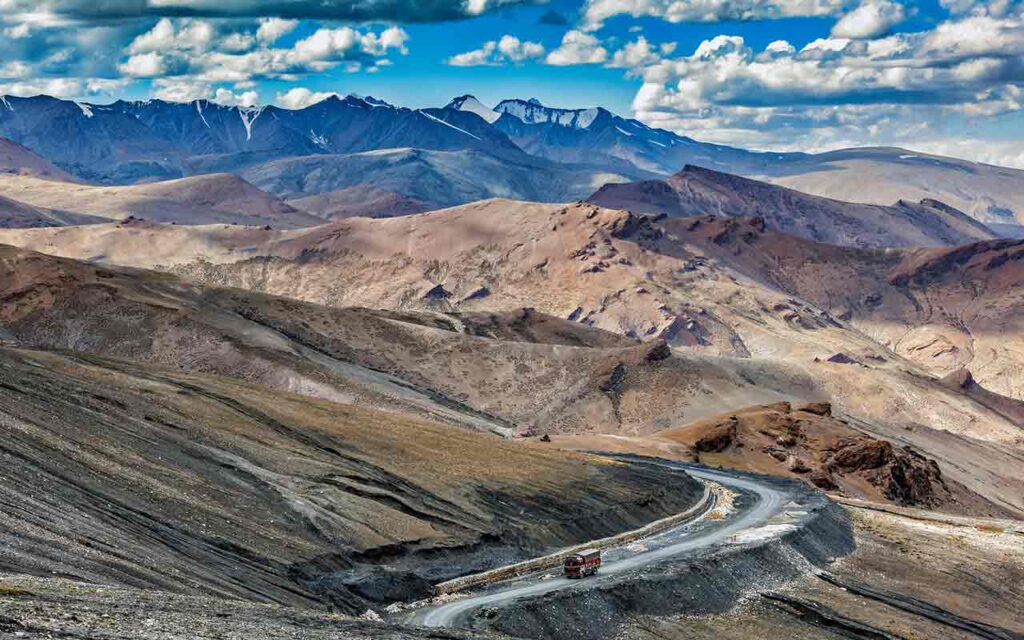Nestled between the Kunlun and Himalaya ranges, one of India’s most awe-inspiring regions. Famous for its barren beauty, crystal-clear lakes, ancient monasteries, and sky-touching mountain passes, Ladakh is not just a destination—it’s an experience. Known as the Land of High Passes, this cold desert in the northernmost part of India attracts travelers from across the world seeking solitude, spirituality, and adventure.
In this guide, we’ll explore why Ladakh should be on your bucket list and how you can make the most of your trip.
Why Visit?
Ladakh offers a unique blend of natural beauty and rich Tibetan-Buddhist culture. With endless landscapes, remote villages, and centuries-old monasteries, it’s a place where time seems to stand still.
What Makes Ladakh Special:
- High-altitude desert landscapes with dramatic valleys
- Unmatched views of snow-clad Himalayan peaks
- Crystal-clear lakes like Pangong Tso and Tso Moriri
- Adventure activities like biking, trekking, and river rafting
- A mix of cultures rooted in Tibetan Buddhism
Best Time to Visit
The region remains cut off from the rest of India during winter due to heavy snowfall. The ideal time to visit Ladakh is between May and September, when roads open and the weather is pleasant.
Seasonal Overview:
- May–June: Melting snow and open roads, perfect for road trips
- July–August: Monasteries celebrate local festivals; Pangong Lake is fully accessible
- September: Fewer tourists, clear skies, and ideal for photographers
How to Reach Ladakh
You can reach Ladakh either by air or road.
By Air:
- Kushok Bakula Rimpochee Airport in Leh is the main airport
- Well-connected to Delhi, Srinagar, and other major cities
By Road:
- Manali to Leh Highway (470 km) – Open June to September
- Srinagar to Leh Highway (434 km) – Open May to October
- Popular among bikers and road-trippers for its scenic routes
Top Places to Visit in Ladakh
1. Leh
The capital city and your entry point to Ladakh, Leh offers monasteries, markets, and cafes with panoramic views.
Don’t Miss:
- Leh Palace
- Shanti Stupa
- Leh Market for Tibetan souvenirs
2. Pangong Tso Lake
Located at 13,860 feet, Pangong Lake is one of Ladakh’s most famous spots, known for changing colors and its blue, mirror-like waters.
Things to Do:
- Camp overnight near the lake
- Stargazing under a clear sky
- Photography at sunrise and sunset
3. Nubra Valley
Reached via Khardung La Pass, one of the highest motorable roads in the world, Nubra Valley is a unique desert landscape with sand dunes and double-humped camels.
Top Attractions:
- Diskit Monastery
- Hunder Sand Dunes
- ATV rides and camel safaris
4. Tso Moriri Lake
A high-altitude lake surrounded by mountains, Tso Moriri is quieter than Pangong and perfect for solitude seekers.
Highlights:
- Spot rare birds and wildlife
- Visit Korzok Village, one of the world’s highest settlements
- Scenic campsites with lake views
5. Magnetic Hill
An optical illusion that makes it appear vehicles are rolling uphill—Magnetic Hill is one of Ladakh’s quirkiest attractions.
Nearby Spots:
- Gurudwara Pathar Sahib
- Confluence of Indus and Zanskar Rivers
6. Lamayuru Monastery
Often called the “Moonland of Ladakh” for its lunar-like landscapes, Lamayuru Monastery is one of the oldest and most stunning monasteries in the region.
Experience:
- Attend morning prayers with monks
- Explore surrounding rock formations
Best Things to Do in Ladakh
1. Road Trip Through High Passes
Drive or bike across Khardung La, Chang La, and Taglang La—some of the highest motorable passes in the world.
2. Try Local Cuisine
Sample Thukpa, Momos, and Butter Tea in Leh’s local eateries.
3. Attend a Monastic Festival
If you visit in summer, don’t miss vibrant monastery festivals like Hemis or Ladakh Festival with dance, music, and rituals.
4. Stargazing and Astrophotography
Ladakh’s low pollution and clear skies make it one of the best places for night sky photography.
Essential Travel Tips
- Altitude Sickness: Spend the first 24–48 hours in Leh acclimatizing. Drink plenty of water and avoid physical strain.
- Permits: Inner Line Permits are needed for places like Nubra, Pangong, and Tso Moriri. Available online or at Leh DC office.
- Cash and ATMs: Carry enough cash, as card facilities are limited outside Leh.
- Network Coverage: Limited mobile coverage. BSNL and Jio work best in Leh.
- Pack Wisely: Warm clothes, sunscreen, lip balm, medicines, and power banks are essentials.
Ideal Duration for a Ladakh Trip
A 7–10 day itinerary is ideal for exploring key areas like Leh, Nubra, Pangong, and monasteries without rushing.
Suggested Route:
- Day 1–2: Leh (acclimatization + local sightseeing)
- Day 3–4: Nubra Valley
- Day 5: Back to Leh
- Day 6: Pangong Lake
- Day 7: Return to Leh
- Day 8–9: Tso Moriri (optional)
- Day 10: Fly out
Sustainable Travel in Ladakh
Tourism is growing fast in Ladakh, and it’s vital to protect its fragile environment.
Responsible Practices:
- Avoid plastic bottles—carry a refillable one
- Stay in eco-friendly accommodations
- Don’t litter in remote areas or near lakes
- Respect local customs and traditions
Final Words
Whether it’s the surreal calm of Pangong Lake, the raw silence of Nubra’s dunes, or the spiritual peace of a monastery—Ladakh is not just a destination, it’s a journey into nature, culture, and yourself. It challenges you with altitude but rewards you with soul-stirring views. A visit here will remain etched in your memory forever.
So gear up, pack light, and embrace the adventure that is Ladakh.

